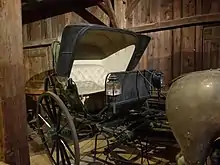Curricle
A curricle was a smart, light two-wheeled chaise or "chariot", large enough for the driver and a passenger and— most unusual for a vehicle with a single axle—usually drawn by a carefully matched pair of horses. It was popular in the early 19th century: its name — from the Latin curriculum, meaning "running", "racecourse" or "chariot"[1] — is the equivalent of a "runabout" and it was a rig suitable for a smart young man who liked to drive himself, at a canter. The French liked the English-sounding term "carrick" for these vehicles. The lightweight swept body with just the lightest dashboard hung with a pair of lamps was hung from a pair of outsized swan-neck leaf springs at the rear. For a grand show in the Bois de Boulogne or along the seafront at Honfleur, two liveried mounted grooms might follow.[2]



In Northanger Abbey Henry Tilney drives a curricle; John Thorpe drives a gig, but buffoonishly praises it as "curricle-hung". Margaret Sullivan found that Jane Austen's assignment of vehicles to the two men was far from arbitrary.[3]
Curricles were notorious for the accidents their drivers suffered.[4] Thus, in the romance novel Miss Carlyle's Curricle by Karen Harbaugh, the heroine inherits the curricle in which her uncle died in a racing accident.[5]
See also
References
- World Wide Words: Curriculum.
- Notes sur les voitures hippomobiles: Le Carrick ou curricle, à pompe. Archived 2006-02-17 at the Wayback Machine À Honfleur: N. Neffe, Gravure d'art contemporain. In French, illustrated.
- Margaret C. Sullivan, "The curricle" 2000. Tilneys and Trap-doors: Keeping irony alive since 1999. Illustrated.
- R v Pigott and Crampton, 1828. Macquarie Law: Decisions of the Superior Courts of New South Wales, 1788-1899. A child is run over by two gentlemen in a curricle.
- The Romance Reader reviews: Miss Carlyle's Curricle by Karen Harbaugh. Archived 2007-11-18 at the Wayback Machine
External links
- Gigs, Cabriolets and Curricles. Jane Austen Centre Bath UK England.